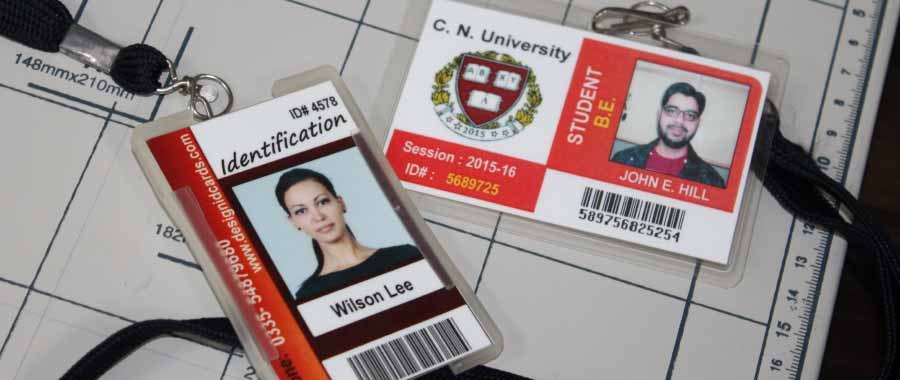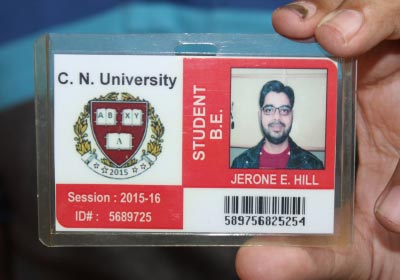Types of Information Included on a Student ID Card
However, the following are common details typically found on a student ID card:

-
Institution Name and Logo:
The name and logo of the educational institution are prominently displayed on the ID card. This helps establish the card's authenticity and affiliation with the institution.
-
Student's Full Name:
The full name of the student is an essential component of the ID card. It helps identify the student and confirms their association with the institution.
-
Student's Photograph:
A recent photograph of the student is usually included on the ID card. The photograph enhances the card's security and aids in visually verifying the identity of the ID cardholder.
-
Unique Student Identification Number:
Each student is assigned a unique identification number by the educational institution. This number is typically printed on the ID card, allowing for easy identification and record-keeping purposes.
-
Issue Date and Expiry Date:
The date of issuance and the expiry date of the ID card are usually mentioned. This helps track the validity of the card, and the expiry date prompts students to renew their ID cards as needed.
-
Signature:
Some ID cards may include a space for the student's signature. This can be useful for comparison purposes or when verifying signatures on official documents and marksheets.
-
Barcode or Magnetic Strip:
To enhance the functionality of the ID card, a barcode or magnetic strip may be included. These can be scanned or swiped to access specific services, such as library resources or secure entry points.
-
Security Features:
Various security features may be incorporated into the ID card design to prevent counterfeiting and unauthorized use. These can include holograms, watermarks, microprinting, or UV ink, among others.
-
Institution Contact Information:
The ID card may display the contact information of the educational institution, including the address, phone number, and website. This enables easy communication and provides a point of reference for any inquiries.
-
Student's Year or Grade Level:
Depending on the educational institution, the ID card may indicate the student's year or grade level. This helps identify the student's academic standing and assists in differentiating between students in different stages.
Including a photograph on a student ID card is a common practice and has several benefits, such as:
-
Identity Verification:
The primary purpose of a student ID card is to verify the identity of the cardholder. By including a photograph, it becomes easier to visually confirm that the person presenting the card is indeed the rightful owner. The photo allows for quick identification and reduces the chances of identity fraud or misuse of the ID card.
-
Security and Fraud Prevention:
A photograph on a student ID card enhances its security features. It makes it more difficult for someone to forge or duplicate the ID card. The unique image of the student acts as an additional layer of protection against unauthorized use or duplication, helping to maintain the integrity of the ID card system.
-
Access Control:
Many educational institutions use student ID cards for access control to certain areas or services. For example, the card may grant entry to libraries, laboratories, or restricted facilities. The photograph ensures that only authorized individuals gain access to these areas, enhancing security and maintaining a safe environment.
-
Recognition and Communication:
Including a photograph on a student ID card helps foster a sense of community within the institution. It allows faculty, staff, and other students to recognize and interact with fellow students more easily. It can also be helpful for administrators and faculty members who may need to identify students in classrooms or other campus settings.
-
Public Safety and Emergency Situations:
In the event of an emergency or critical situation on campus, having a photograph on the student ID card can aid in identifying individuals quickly. It enables emergency responders, security personnel, or campus authorities to verify the identity of students and provide appropriate assistance if needed.
When including a photo on a student ID card, it's essential to ensure that the photograph meets certain criteria. Generally, the photo should be a recent, clear, and passport-style image of the student's face. The background should be plain, and the student's face should be clearly visible without obstructions like hats or sunglasses. Adhering to these guidelines helps maintain the effectiveness of the ID card as a reliable means of identification.
Color Selection is very Important when Designing a Student ID Card
Color selection plays a significant role in the design of a student ID card. The choice of colors can impact the card's overall aesthetics, readability, branding, and functionality. Here are several reasons why color selection is important:
-
Visual Appeal and Branding:
Colors evoke emotions and have psychological effects on individuals. By carefully selecting colors that align with the institution's branding or visual identity, the student ID card can create a cohesive and professional image for the educational institution. Consistent color schemes across various materials help reinforce brand recognition and create a sense of unity.
-
Differentiation and Hierarchy:
Effective color selection can be used to differentiate between various levels, departments, or types of students. For example, different colors or color accents can be used to represent different grade levels, programs of study, or faculty affiliations. This helps to quickly identify and categorize students, allowing for efficient communication and resource allocation within the institution.
-
Readability and Accessibility:
The color combination chosen for the ID card should ensure that all text and information are easily readable. Contrast between background and text colors should be sufficient to provide clear legibility, especially for important details like the student's name and ID number. Additionally, consideration should be given to individuals with color vision deficiencies, ensuring that the chosen colors are accessible to all.
-
Security and Anti-Counterfeiting Measures:
Colors can be utilized as a security feature on ID cards to help prevent counterfeiting or tampering. The use of specific color schemes, UV inks, or color-shifting elements can make it more challenging to replicate the ID card accurately. Incorporating color-based security features can enhance the card's authenticity and deter fraudulent activities.
-
Functionality and Practicality:
Colors can also serve functional purposes on student ID cards. For instance, different colors can be assigned to specific groups of students or staff members, helping to identify their roles or access privileges. This can be particularly useful for access control, where color-coded ID cards can streamline security checks and identify authorized individuals more efficiently.
-
Cultural or Symbolic Significance:
Color choices may also be influenced by cultural or symbolic meanings. Certain colors may carry specific connotations or symbolism that are relevant to the educational institution or the local community. Taking such factors into account can help create a card design that resonates with the institution's values and traditions.
Security Features can be included in a Student ID Card Design
A student ID card can incorporate various security features to enhance its authenticity, prevent counterfeiting, and protect the personal information of students. Here are some commonly used security features that can be included in a student ID card design:

-
Holograms:
Holographic overlays or holographic patches can be added to the ID card design. These holograms can be difficult to replicate and provide a visually striking and distinctive feature that is hard to counterfeit.
-
UV/Invisible Ink:
UV ink can be used to print invisible patterns, texts, or images on the ID card. These elements are only visible under ultraviolet light, making it challenging for counterfeiters to reproduce them accurately.
-
Microtext:
Tiny, finely printed text can be incorporated into the design, such as the school name or logo. Microtext is typically difficult to reproduce accurately, particularly at a smaller scale, which adds an additional layer of security.
-
Guilloche Patterns:
Intricate, complex, and repetitive patterns, known as guilloche patterns, can be used on the ID card design. These patterns are difficult to replicate accurately without specialized printing techniques.
-
Tamper-evident Features:
Incorporating tamper-evident features helps identify any attempts to alter or tamper with the ID card. This can include holographic or color-shifting overlays, security seals, or a signature panel that reveals tampering attempts when scratched or peeled.
-
Barcodes or QR Codes:
Barcodes or Quick Response (QR) codes can be printed on the ID card, containing encoded information such as the student's ID number. These codes can be scanned for verification purposes, providing an additional layer of security and making it easier to authenticate the card.
-
Embedded Technologies:
Advanced ID card designs can include embedded technologies like RFID or smart chips. These technologies can store encrypted student information and facilitate contactless authentication, making it more difficult for unauthorized individuals to replicate or clone the card.
-
Laser Engraving:
Laser engraving can be used to etch specific elements, such as the student's photo or school logo, directly onto the ID card's surface. This technique provides a highly secure and durable feature that is hard to replicate using traditional printing methods.
-
Overt and Covert Security
Features:
Overt security features are easily visible and can be checked without any special equipment, such as holograms or guilloche patterns. Covert security features require specific tools or techniques to detect, such as invisible ink or microtext.
-
Personalization:
Including various student-specific information, such as a unique ID number or a photograph, helps authenticate the ID card easily and prevent unauthorized access by the other person.
It's important to note that while these security features can enhance the overall security of a student ID card, no single feature can guarantee complete security. Implementing a combination of multiple features and regularly updating designs can help stay ahead of counterfeiters and protect the integrity of the ID cards.